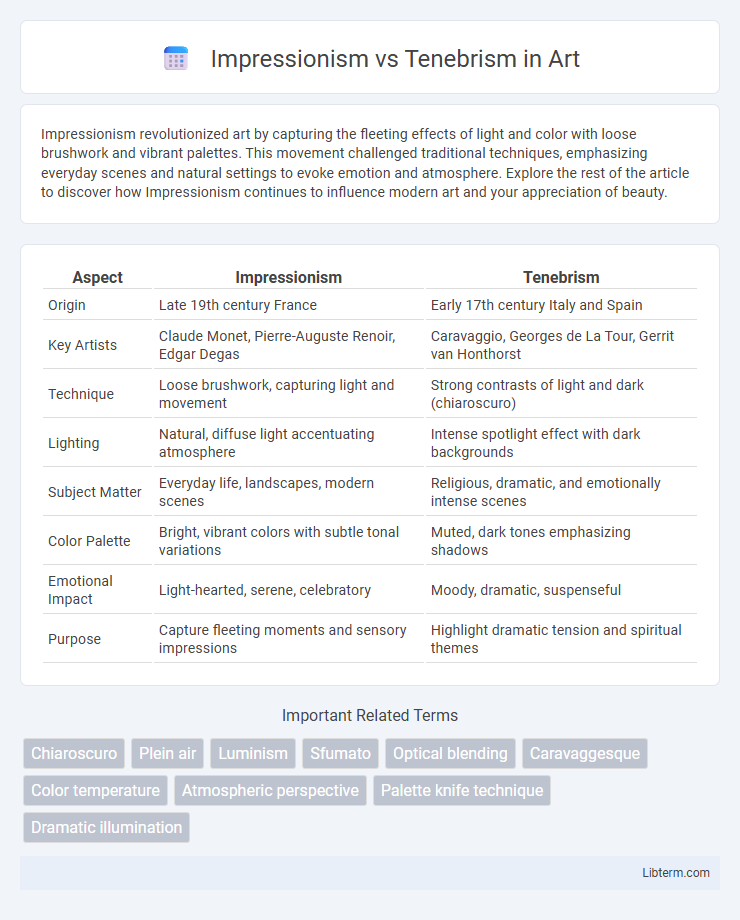Impressionism revolutionized art by capturing the fleeting effects of light and color with loose brushwork and vibrant palettes. This movement challenged traditional techniques, emphasizing everyday scenes and natural settings to evoke emotion and atmosphere. Explore the rest of the article to discover how Impressionism continues to influence modern art and your appreciation of beauty.
Table of Comparison
| Aspect | Impressionism | Tenebrism |
|---|---|---|
| Origin | Late 19th century France | Early 17th century Italy and Spain |
| Key Artists | Claude Monet, Pierre-Auguste Renoir, Edgar Degas | Caravaggio, Georges de La Tour, Gerrit van Honthorst |
| Technique | Loose brushwork, capturing light and movement | Strong contrasts of light and dark (chiaroscuro) |
| Lighting | Natural, diffuse light accentuating atmosphere | Intense spotlight effect with dark backgrounds |
| Subject Matter | Everyday life, landscapes, modern scenes | Religious, dramatic, and emotionally intense scenes |
| Color Palette | Bright, vibrant colors with subtle tonal variations | Muted, dark tones emphasizing shadows |
| Emotional Impact | Light-hearted, serene, celebratory | Moody, dramatic, suspenseful |
| Purpose | Capture fleeting moments and sensory impressions | Highlight dramatic tension and spiritual themes |
Introduction to Impressionism and Tenebrism
Impressionism emerged in the late 19th century, characterized by its vibrant use of color, loose brushwork, and emphasis on capturing natural light and everyday scenes. Tenebrism, originating in the early 17th century during the Baroque period, is known for its dramatic contrasts of light and dark, where intense chiaroscuro creates a theatrical effect with deep shadows enveloping parts of the composition. Both styles represent distinct approaches to light and atmosphere, with Impressionism focusing on fleeting moments and natural illumination, while Tenebrism emphasizes bold, dramatic lighting to evoke emotion and tension.
Historical Origins of Impressionism
Impressionism originated in the late 19th century in France, emerging as a reaction against the rigid academic standards of the art establishment, emphasizing light, color, and everyday scenes captured outdoors. In contrast, Tenebrism evolved during the Baroque period, characterized by dramatic chiaroscuro and intense contrasts between light and dark to evoke emotional intensity. The development of Impressionism marked a shift towards modern art, breaking from the theatrical and moody style of Tenebrism with its focus on natural light and momentary impressions.
Historical Roots of Tenebrism
Tenebrism, rooted in the Baroque era of the early 17th century, originated as a dramatic style of painting characterized by stark contrasts between light and dark, emphasizing chiaroscuro to enhance emotional intensity. Caravaggio is widely credited as the pioneer of Tenebrism, using deep shadows to create theatrical and realistic scenes that contrasted with the brighter, more naturalistic approaches in Renaissance art. This technique influenced many artists seeking to evoke mystery and depth, distinct from the lighter, atmospheric brushwork and vibrant colors defining Impressionism, which emerged in the late 19th century.
Core Principles of Impressionist Art
Impressionist art emphasizes capturing the fleeting effects of light and color through loose brushwork and open compositions, prioritizing sensory impressions over detailed realism. Its core principles include the use of vibrant colors, natural light, and everyday scenes to evoke atmosphere and movement. This approach contrasts sharply with the dramatic chiaroscuro and intense emotional focus central to Tenebrism.
Defining Characteristics of Tenebrism
Tenebrism is characterized by dramatic lighting contrasts with intense chiaroscuro, where deep shadows dominate and sharply illuminate specific subjects, creating a theatrical and emotionally charged atmosphere. Unlike Impressionism, which emphasizes light diffusion and vibrant color through loose brushstrokes, Tenebrism relies on stark light-dark contrasts to enhance volume and depth. Pioneered by Caravaggio, this technique often portrays scenes with heightened realism and psychological intensity through focused illumination against nearly black backgrounds.
Key Artists in Impressionism
Key artists in Impressionism include Claude Monet, Pierre-Auguste Renoir, and Edgar Degas, who emphasized capturing light and natural scenes with loose brushwork and vibrant colors. Impressionism contrasts sharply with Tenebrism, a style dominated by Caravaggio and Gerrit van Honthorst, which utilizes dramatic lighting and stark contrasts between light and dark to evoke emotional intensity. Monet's series paintings, Renoir's focus on human figures, and Degas' interest in movement highlight Impressionism's break from Tenebrist chiaroscuro and tenebristical use of shadow.
Prominent Figures of Tenebrism
Tenebrism is characterized by dramatic chiaroscuro and intense contrasts between light and dark, exemplified by prominent figures such as Caravaggio, whose paintings revolutionized Baroque art with their raw emotional depth and realism. Artemisia Gentileschi expanded on this tenebrist style, infusing her works with powerful female protagonists and vivid storytelling. Georges de La Tour also contributed significantly, using subtle lighting effects to create contemplative and intimate scenes.
Techniques and Approaches: Light and Shadow
Impressionism emphasizes natural light and its changing qualities, using loose brushwork and vibrant colors to capture fleeting moments and atmospheric effects. Tenebrism employs dramatic contrasts between deep shadows and intense illumination, creating a stark chiaroscuro that highlights emotional intensity and three-dimensional form. While Impressionism diffuses light for a softer, more spontaneous feel, Tenebrism's focused lighting enhances theatricality and depth through pronounced darkness.
Thematic Differences Between Impressionism and Tenebrism
Impressionism captures fleeting moments with vibrant colors and light, emphasizing everyday scenes and natural landscapes, while Tenebrism uses stark contrasts between light and dark to evoke intense emotional drama and spiritual themes. Impressionist artworks often explore modern life and spontaneity, portraying the transient effects of light and atmosphere. In contrast, Tenebrism centers on religious, mythological, or moral subjects, utilizing deep shadows to heighten the sense of mystery and tension.
Lasting Influence on Modern Art
Impressionism revolutionized modern art by emphasizing light, color, and everyday scenes, paving the way for abstract and contemporary movements with its focus on perception and spontaneity. Tenebrism, characterized by dramatic contrasts of light and shadow, deeply influenced Baroque and later expressionist artists by intensifying emotional impact and theatricality in visual storytelling. Both styles have left enduring legacies, with Impressionism shaping color theory and brushwork approaches, while Tenebrism continues to inspire chiaroscuro techniques in modern visual narratives.
Impressionism Infographic

 libterm.com
libterm.com